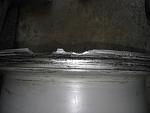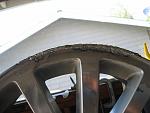I got a new welding toy to play with... a bottle of Helium! (Old 155cf Argon, meet your new pal: 330cf Helium!)

I found the tank on craigslist as basically an empty tank for $100, and it came with a balloon filling gauge/regulator. I then got the tank filled (exchanged) from my local welding supply for another $120 out the door.
I was hoping to be able to mix the helium and argon with a "Y", but I measured one of my regulators puts out 30 psi and another puts out 50 psi, (so I think that might not work too well.)
This aluminum wheel will be my first experiment (and also a paid welding job) where I will try the Helium. The outer wheel lip was previously repaired with bondo/body filler, which cracked out when a tire was being mounted, a poor repair solution. I hammered and ground it all out (and I even found an extra "hidden pocket" of the stuff! Tapping with a hammer, the filler sounds dull compared to the sharp metallic ring of aluminum), and prepped it down to fresh aluminum surfaces with a flap wheel.
Before prep:

After prep:
For the Helium test, I set up everything up for welding just as I would if I were using Argon: 3/32" 1.5% lanthanated tungsten (sharpened with blunted tip), 20%EP (AC mode), and footpedal for current control (with full machine output of 200 amps current at wide pedal down.) And I used a #6 stubby gas lens with 15 cfh gas flow.
First thing I noticed when starting the pre-flow, was the floating ball in the regulator floats up and down with some more "springiness" in Helium than it does with Argon. And the sound of the Helium coming out of the torch even sounds different (quieter) than argon.
The arc through Helium was definitely harder to start than it was through Argon. (I was thinking, it was good that I was using a lanthanated electrode and not pure or zirconiated, which tend to be even more difficult to start!) I was really amazed how I had an instant puddle on the cold aluminum wheel, even with very light current. The footpedal position that what would have just "etched" the surface with cleaning action on Argon, actually left a 3/16-1/4" wide swath of melted metal surface on Helium! So with Helium, it wasn't possible to just "etch" the surface, it was melted aluminum surface, or nothing at all. (Crazy stuff!) I don't think I ever floored the machine; it felt like I did most of the welding at 20%-40% pedal depression. I have a feeling I would have been running double the current or more if I was using Argon and may have perhaps floored it, at least at the start.
Anyhow, I was getting some black "smut" on the outer edges of my weld area I haven't figured out yet, but I think it's because the lightweight Helium shielding gas is doing a 180 degree turn out of the cup and floating upwards. I'll have to try pumping up the cfh and see if it cleans up the dirtiness next time. Amazingly, it wasn't anything that posed any problems welding over - I was able to melt through it effortlessly with a new puddle. It did just look a little bit like hell. (No problem on this application, all the surface will be getting ground off anyway.) The surface of the puddle however looked bright and shiny under the arc - no oxides floating on the surface were noted.
After some grinding (because I got a little filler rod feeding happy on the first pass), I did a second welding pass to further fill in and 'touch up' any low spots. I also noted that the aluminum deposited in the first pass I ground down, was totally solid and free of porosity and inclusions (a good thing!). And after the second weld pass I'll say, it's ready to go back to my wheel repair customer for them to further work over. (They will further grind/smooth, straighten as needed, and paint.)

I think I'd like to do some more scientific back to back tests of He vs Ar... I need to work out a way to mix them in various ratios, I'm thinking.





 Reply With Quote
Reply With Quote



 )
)






